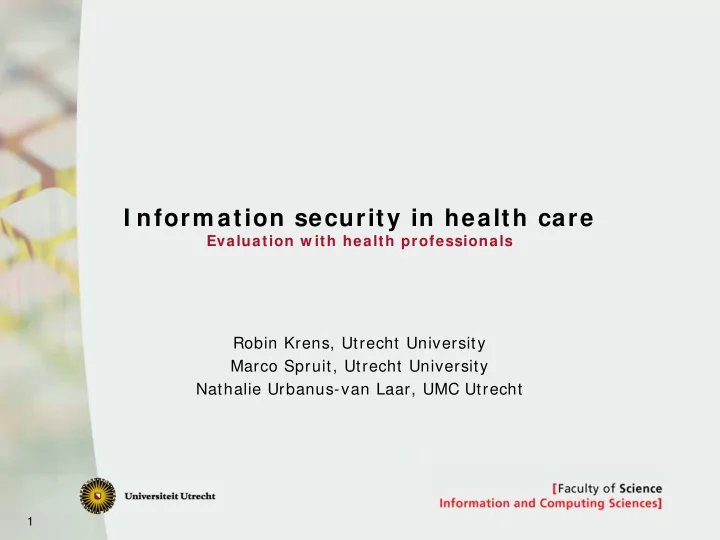

I nform ation security in health care Evaluation w ith health professionals Robin Krens, Utrecht University Marco Spruit, Utrecht University Nathalie Urbanus-van Laar, UMC Utrecht 1
Agenda Introduction to information security Research approach Evaluation Instrument (ISEE) Results Summary and discussion 2
I ntroduction the scope of inform ation security* Availability: Gone?! But I need that information. Now! } Safety of patients Integrity: But the medical record said blood type B+ … } Confidentiality: Whoops, now the whole world knows you Privacy of patients have Gonorrhea! 3 * Defined as by the Dutch Health Care inspectorate
I ntroduction research trigger Information security in Dutch hospitals is lacking (IGZ & CBP, 2008) Risks for both health care and privacy Staff as weakest link National EMR infrastructure New possibilities A narrow focus on technical oriented approaches (Siponen, 2005) and the confidentiality aspect (Barber, 2002): “the issues of integrity and availability will probably deserve more attention than the issues of confidentiality as medical information systems become more inter-twined with clinical practice” 4
I ntroduction approaches* Technology or solutions i.e. intrusion detection systems Processes or checklists and standards i.e. ISO27002, CoBIT People or perception and awareness * Dhillon & Backhouse (2002) Current directions in IS security research: towards socio-organizational perspectives 5 * Siponen (2005) An analysis of the traditional IS security approaches: implications for research and practice
I ntroduction people’s perspective Hey! Let’s evaluate with the day-to-day users: Within a hospital department day-to-day users are: Doctors Nurses Management Supporting staff How can we evaluate information security from a health professional's perspective? 6
Evaluation instrum ent concepts Not from scratch, but usage of an existing instrument MaPSaF* : How safe is our patient? MaPSaF elements: Evaluation with 6 – 12 health care workers Workshop like evaluation A maturity framework A variety of dimensions * Manchester Patient Safety Framework (NHS and University of 7 Manchester, 2006)
Evaluation instrum ent concepts ( 2 ) 8
Research approach* Information Security Employee Evaluation (ISEE) Step 1: Building • re-use of MaPSaF • literature review • focus group (delphi-like) Step 2: Piloting ISEE • applying the instrument as workshop (5x) *Design Science as defined by Hevner (2004) 9
Step 1 : Building I SEE Dimension Description Examples Priority of security at the budget for security, Priority department. problem-solving Handling of security- system downtime and Incident Handling related incidents. restore Awareness and awareness on privacy Responsibility responsibility. Effective implementation inadequate systems Functionality of security mechanism. of security Communication on security communication about Communication related issues. legislation Supervision and control on unauthorized access to Supervision usage. data, logging and audit Training and education on usage of mobile devices, Training and security related issues. usage of encryption education 10
Step 1 : Building I SEE Combined with underlying Bureaucartic framework of Westrum (1998), Generative Pathologic Proactive Reactive Level Parker & Hudson (2001) How do we rate our department? Dimension Priority Added examples for each cell Incident handling Responsibility Functionality Communication Supervision Training and education 11
Step 2 : Piloting I SEE Piloting the instrument as workshops (~ 1.5 hours) Bureaucartic Generative Pathologic Proactive Reactive Level A crosscut of a hospital Dimension department (6 – 10 persons). Priority Radiology, UMC 7 participants, Incident handling Utrecht different disciplines Responsibility Radiotherapy, 8 participants, UMC Utrecht different disciplines Functionality Skin diseases, 10 participants, LUMC different disciplines Communication Hematology, 7 participants, Supervision LUMC mostly nursing Training and education Urology, 8 participants, UMC Utrecht different disciplines 12
Piloting I SEE as w orkshops Workshop structure: Fill out instrument individually Compare scores Discuss and write down key issues • “I don’t know what to do in case of a system failure” • “The systems are slow and are a threat to the patient!” • “Am I allowed to mail these files to the general practitioner?” Make action plan Reflection on workshop and instrument 13
Pilot study evaluation Incidents: “When the allergy EHR is restored, my session is already over” Functionality: “It’s a mess, we have protocols on where to put what data, but this happens rarely” Supervision: “Supervision is pure ethics” Training: “I know about the Hippocrates oath, but I have no clue if I’m allowed to mail files to general practitioners” 14
Discussion and conclusion The ISEE instrument Based on MaPSaF Face validated by experts and subject matter experts Feasible and acceptable within the amount of time Practically useful • Highlights weak points within departments More workshops More data Generic dimensions, need for specification Survey-like instrument 15
Recommend
More recommend